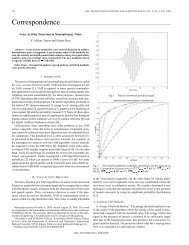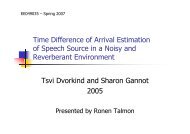Thesis (PDF) - Signal & Image Processing Lab
Thesis (PDF) - Signal & Image Processing Lab
Thesis (PDF) - Signal & Image Processing Lab
Create successful ePaper yourself
Turn your PDF publications into a flip-book with our unique Google optimized e-Paper software.
6.2. MORPHOLOGICAL OPERATIONS ON THE EXTREMA-WATERSHED TREE 81<br />
The result of the erosion and the opening operations on the image Lena are shown<br />
in Figs. 6.4 and 6.5, respectively. As one can see, these operators create no significant<br />
artifacts (unlike the the trenches that are added by boundary topographic operators,<br />
as shown in Chapter 4). Very small components were removed, whereas the larger<br />
ones were preserved (by opening) or shrank (by erosion). Moreover, the average gray<br />
level of the picture did not change; in particular, the picture did not become darker,<br />
which is what usually happens after a standard erosion or opening. In addition,<br />
in Fig. 6.7 the filtering effect on a corrupted Lena image is shown. The image is<br />
corrupted with salt and pepper noise constituting of random black and white pixels.<br />
It is seen that after the filtering there is no sign of noise, and the resulted image is<br />
very similar to a filtered image without the noise. A comparison between the two<br />
results (filtered with and without the noise) is shown in Fig. 6.8. The image shown is<br />
the gray level difference between the filtered original and filtered noisy images, both<br />
obtained by opening and erosion. An additional example is shown in Figs. 6.11 and<br />
6.10, with respect to the synthetic image “Simba”. The Fig. 6.12 results of filtering<br />
a binary image, first introduced in Fig. 1.1, are presented. All the noise, except for<br />
noise on the edges, has been removed.
















